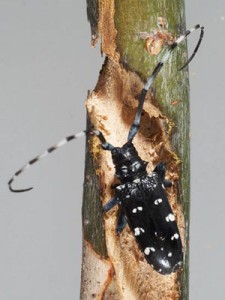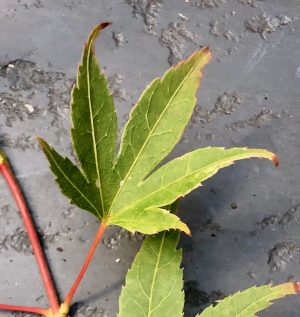Protecting our trees and woodlands.

Globalisation is the process by which economies and cultures are drawn together; they become more inter-connected through the flow of trade, capital, people and technology. This has occurred in part due to the rapid growth of air travel, container shipping etc. so that there are now massive movements of people and goods (both raw and manufactured). One positive aspect of globalisation is that we have access to foods and materials from all over the world. A downside is that disease, parasites and pests can ‘hitch a ride’ with people or materials and goods as they move across the world. Plants and animals can also change their geographical range / distribution as a result of climate change. The woodlands blog has outlined some of the problems associated with various ‘alien or invasive’ species, for example,
 Though there have been many incidences of alien species arriving in the country, border controls have in many cases ensured that ‘outbreaks’ have been localised and / or controlled. It is thought that many insects arrive inside wood packaging material, imported trees and shrubs or the soil in which they are growing.
Though there have been many incidences of alien species arriving in the country, border controls have in many cases ensured that ‘outbreaks’ have been localised and / or controlled. It is thought that many insects arrive inside wood packaging material, imported trees and shrubs or the soil in which they are growing.
A Citrus longhorn Beetle (Anoplophora chinensis) was found in Rutland; this beetle may be found on imported trees, such as Japanese Maple (Acer palmatum). Each finding or interception (as the finding of an occasional alien insect is termed) is treated seriously. This particular beetle, which is native to China and Japan, has established itself in Lombardy and other parts of the EU. The Lombardy authorities have responded by destroying thousands of mature trees to stop the spread of the beetle.
A related species is a particular concern, namely the Asian longhorn beetle (A. glabripennis) - image below. This is another non-native wood-boring pest which could pose a serious threat to a wide range of broadleaved woodland trees in the U.K. Its natural range is in China and neighbouring countries. Fortunately, the Asian longhorn beetle is not present in the United Kingdom, though one inception of a breeding population was found in Paddock Wood, Kent, England, in 2012. Rapid eradication and annual surveys since then have found no evidence of the beetle. Unfortunately, this beetle has become established and caused significant damage in parts of North America; there have also been outbreaks in several European countries, including Italy, some of which are still subject to control measures. Vigilance is always needed.
To protect plant health, the Department for Environment, Food and Rural Affairs formulates policy and enforces controls and restrictions on the import and movement of certain plants and materials such as soil. forestresearch.gov.uk has many useful resources to enable one to identify strange / unusual insects; see, for example, their pest and disease page - click here. Or visit Tree Alert.
TreeAlert was set up to gather information about the health of our trees, woodlands and forests. Information submitted supports tree health monitoring and surveillance work, helping to protect trees across the country. Apart from keeping ‘alien insects / animals’ at bay, it is also important to protect our native flora and fauna from invasive plants.
Featured image above : Crown Copyright GB NNSS (Non native species secretariat) gallery
Asian long horn beetle - courtesy of P.S. Meng, K. Hoover, and M.A. Keena. [Public domain] - from https://commons.wikimedia.org/wiki/File:ALBadult.jpg 
Comments are closed for this post.
